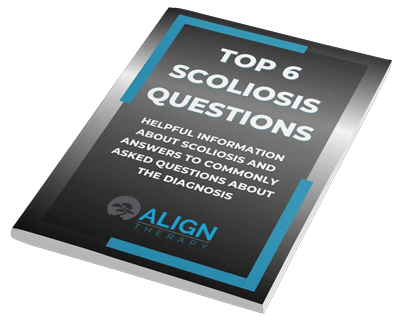As a spine specialist I tend to see a lot of complicated cases involving scoliosis or back pain. Lately, I have seen quite a few interesting cases that are more complex or have been going on for a long time. What is interesting to me is how similar the complex cases are to the simple cases in terms of what we do for treatment.
I wanted to share the 5 things I wish all of my back pain and scoliosis patients understood to hopefully help those struggling with spine issues. As I think about them, it makes me realize these are things that would be good to understand with many other aches and pains as well.
Here goes!
1. Pain or spinal deformity does not mean surgery!
 It is really interesting to me how many people think when they have back pain for an extended period of time, they must need surgery. Even the kids I see with scoliosis, unless it gets over 50 degrees, which is a big curve, surgery is not indicated.
It is really interesting to me how many people think when they have back pain for an extended period of time, they must need surgery. Even the kids I see with scoliosis, unless it gets over 50 degrees, which is a big curve, surgery is not indicated.
I am not anti-surgery by any means, but my goal is to help people stay out of the operating room if at all possible. If there is instability in the spine or just too big of a curve we may have no choice. Otherwise, conservative treatment can be very effective.
2. We usually don’t need imaging to effectively treat you.
This is a big one! I have seen many patients who insist on needing an x-ray or MRI before starting treatment. Their reasoning is they would like to know for sure what is going on before trying to treat it. I totally understand this way of thinking, but there are some problems with it. 
First, imaging cannot show where pain is located. Yes, we can see if there is a disc bulge or arthritis, but we cannot see if those things are actually what is causing the pain. In fact, studies have shown MRIs are NOT very good at determining how bad something is or if it is causing the pain.
If we just use the MRI to determine how bad the pain is, we usually miss the mark. They are amazing machines and it is a miracle that we can get such a good picture of soft tissues, but they are really over used.
The exception to not needing imaging is spinal deformity. When treating scoliosis or kyphosis, I usually want to have an x-ray to make sure there isn’t anything else causing the deformity. This is to look at the structure of the spine and gives us a chance to measure it accurately.
So, one question you may ask… “How do you know what is going on if you don’t see it on an image?”. In the clinic, we use tests that have been developed over decades and researched to provide this information. By the end of an evaluation, we have enough information to treat it effectively.
3. Just do it! The exercises that is.
One of the biggest struggles I have as a therapist is to get my patients to do their home exercise program. There are many reasons this is a challenge, but it is also one of the determining factors of how well that person will do with PT. 
After we evaluate something, we develop a plan on how to get that person back to 100%. This involves things we do in the clinic, like manual therapy and modalities, but it also involves things we have them do at home.
Here’s the secret! The things we do in the clinic help in the short term to reduce pain, stiffness, etc. BUT, the things we have you do at home are the things to really fix the underlying problem. This helps to strengthen the things that are weak, loosen the things that are tight, and retrain the muscles and joints.
Without doing this at home, you are really asking for the pain to return. To get to the underlying problem, we need consistency at home.
I wish I could say that we “fix” people in the clinic, but really what we are trying to do is teach them how to fix themselves.
4. Activity is Good!
One of the things I see happen with back pain the most is many people will become sedentary. This could be because it hurts to do those things, or it may be an attempt to reduce the back pain by resting.
 While some rest initially may be helpful, most of the time I want my patients to be active. Staying active helps to reduce the weakness and stiffness that comes with being sedentary. It also helps our tissues to get good blood flow and oxygen and heal stronger.
While some rest initially may be helpful, most of the time I want my patients to be active. Staying active helps to reduce the weakness and stiffness that comes with being sedentary. It also helps our tissues to get good blood flow and oxygen and heal stronger.
(I cover this in my Free Report on Myths surrounding Back Pain)
Now, I am not saying that if you have back pain come on, then you should start training for a Spartan Race. I am just saying try to stay as active as you can. Still listen to your back and don’t do things that significantly irritate it. Listening to your back doesn’t mean avoiding all pain however.
It is a fine line, but the patients I see do the best are the ones that are able to stay active.
With my scoliosis patients, I get asked a lot of times what activities they shouldn’t do. I rarely will restrict them from doing any specific activity, but if they are having pain I instruct them to let pain be their guide.
5. Don’t worry, you WILL get better!
Many times, when you are having back pain, it seems like you will never be “normal” again. Trust me, I have had back pain on many occasions, and I have felt that feeling of, “Oh man, this is just how it is going to feel the rest of my life!” . It is a scary feeling! 
With the right help and treatment, there is definitely a light at the end of the tunnel. It will take some work to get there, but it is very rare for us to see patients who just don’t respond at all. If that is the case, we still have other things we can refer for like injections or medication, but most of the time it doesn’t come to that.
With spinal deformities like scoliosis, you will always have that deformity. We can’t take that away, but we can see improvements in pain, posture, strength, and reduce how much it is affecting your life.
Really, the bottom line is that there is hope! I treat people with back pain daily, and we see some amazing results.
In Summary:
If you, or someone you know are suffering from back pain or have been diagnosed with a spinal deformity (scoliosis, kyphosis, etc), there are many things that can be done.
You are not on the fast track to surgery, and you don’t need an MRI to be treated. Conservative treatment with physical therapy is effective and can help you get back to activity and your life.
If you have specific questions about YOUR problem, please don’t hesitate to email me at david@aligntherapyutah.com. I love receiving questions and helping people find answers.
There is so much more that we can do than wait and see if it gets worse!!
Thanks for reading.



